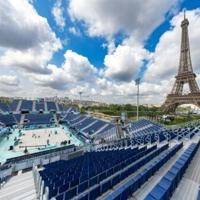The stands have fallen silent and the Athletes’ Village is now empty. So, what happens to all the equipment now that the 2024 Paris Olympics have come to a close? Organizers have a plan in place.
Traditionally, the Olympics have been associated with excessive waste, with entire stadiums sometimes left abandoned after the two-week sporting event moves on. However, Paris aimed to tackle this issue by utilizing temporary venues to minimize construction work and pushing suppliers to consider a “second life” for the equipment they provided, from tennis balls to beach volleyball sand.
“Before making any purchases, we considered the future use of each item,” explained Georgina Grenon, sustainability director for Paris 2024, in an interview with AFP last week.
This approach is innovative for a major global sports event, as Grenon’s team explored ideas from previous FIFA tournaments and Olympics before deciding to develop their own strategy.
“We even consulted with experts in the ‘circular economy’ and could not find any previous examples of this being done,” she added.
The first step involved creating an inventory of all the items needed for the massive event.
“It’s similar to organizing a wedding – if you know you have 100 guests, you’ll need ten tables, 100 chairs, etc.,” Grenon explained.
The Paris Olympics featured 32 different sports and attracted around 10 million spectators.
“After compiling the list, we realized we needed about six million items, six million objects,” Grenon noted.
– Positive Impact on Sports Clubs –
During the procurement process, Paris 2024 included a requirement in every tender for suppliers to propose a second life for their products.
“We wanted them to understand that we were not just buying objects. It was up to them to suggest the best reuse model,” Grenon said.
Many of the facilities and equipment used for the Olympics will be repurposed for the Paralympics, which will take place from August 28 to September 8.
Following the Paralympics, these items will find new homes.
For example, the fine sand used in the beach volleyball court near the Eiffel Tower will be given to a club in the Paris region. Paris 2024 logos will be removed from podiums for reuse elsewhere.
Additionally, the 600,000 pieces of office furniture leased from Lyreco will be reclaimed and repurposed by the company to launch a second-hand furniture business.
Other items, such as the mattresses made from recycled plastic, will be donated to the French army, while their cardboard bases will be recycled. Tennis balls used at Roland-Garros and other sports equipment will be donated to French sports clubs.
– Addressing Sustainability Concerns –
According to Grenon, 90 percent of the six million items have confirmed second-life plans, with final agreements being finalized for the rest.
The organizing committee is also offering fans the opportunity to purchase souvenirs, including flags and torches used during the Games.
Facilities like swimming pools, climbing walls, and skateboarding parks will be relocated, with many of them heading to the Seine-Saint-Denis suburb northeast of Paris.
Despite the focus on sustainability, the Games have faced criticism for their environmental impact and accusations of “greenwashing” by major sponsors. However, Grenon believes Paris 2024 has set a precedent for future events and has attracted academic interest.
“Our goal was to make these Games a testing ground and be a catalyst for change,” she said.
adp/gj





